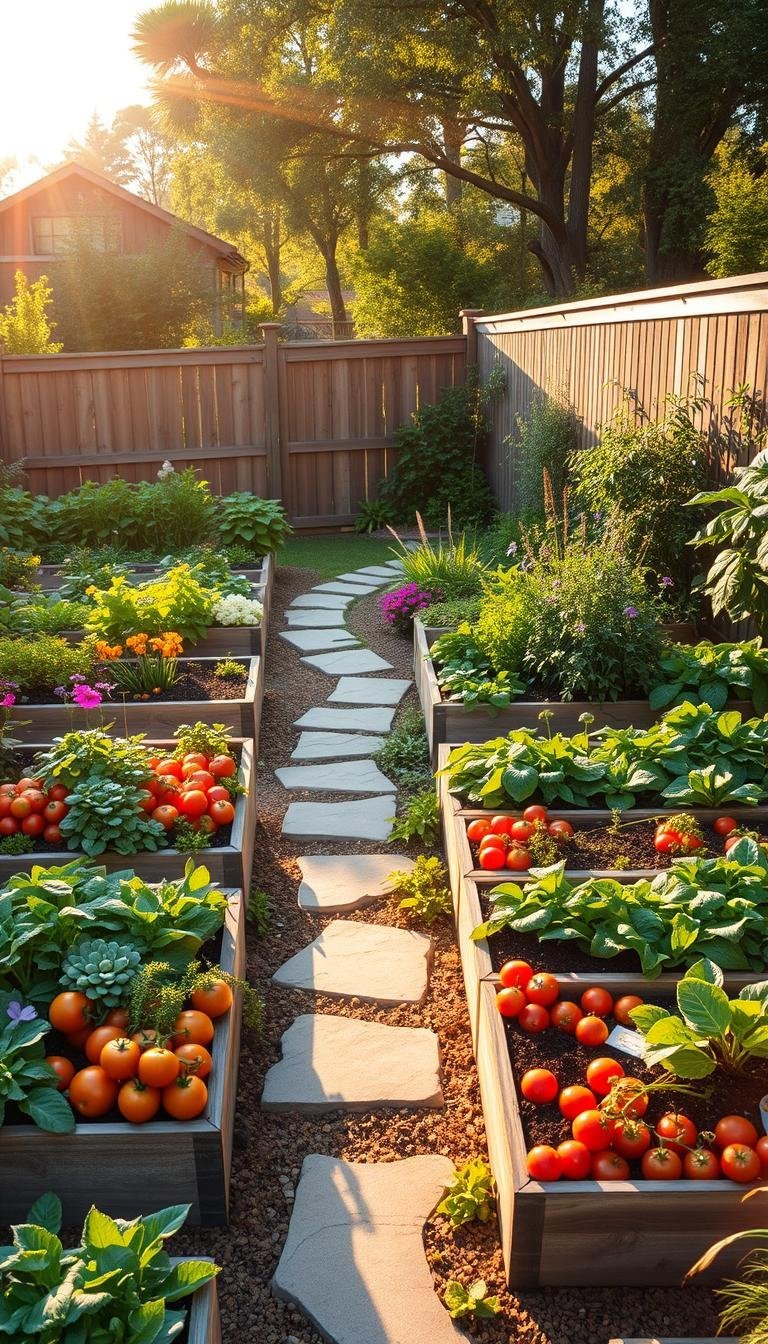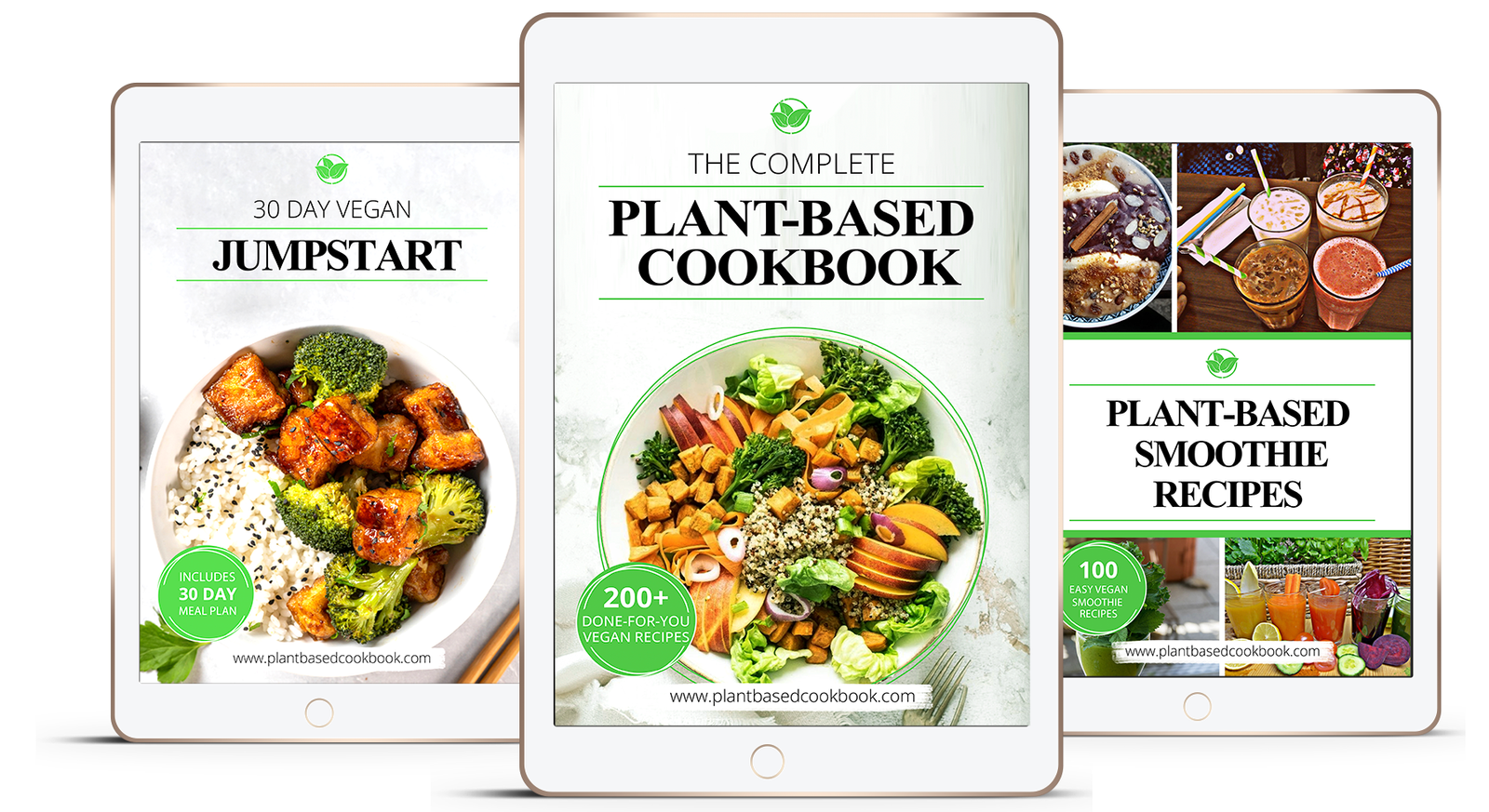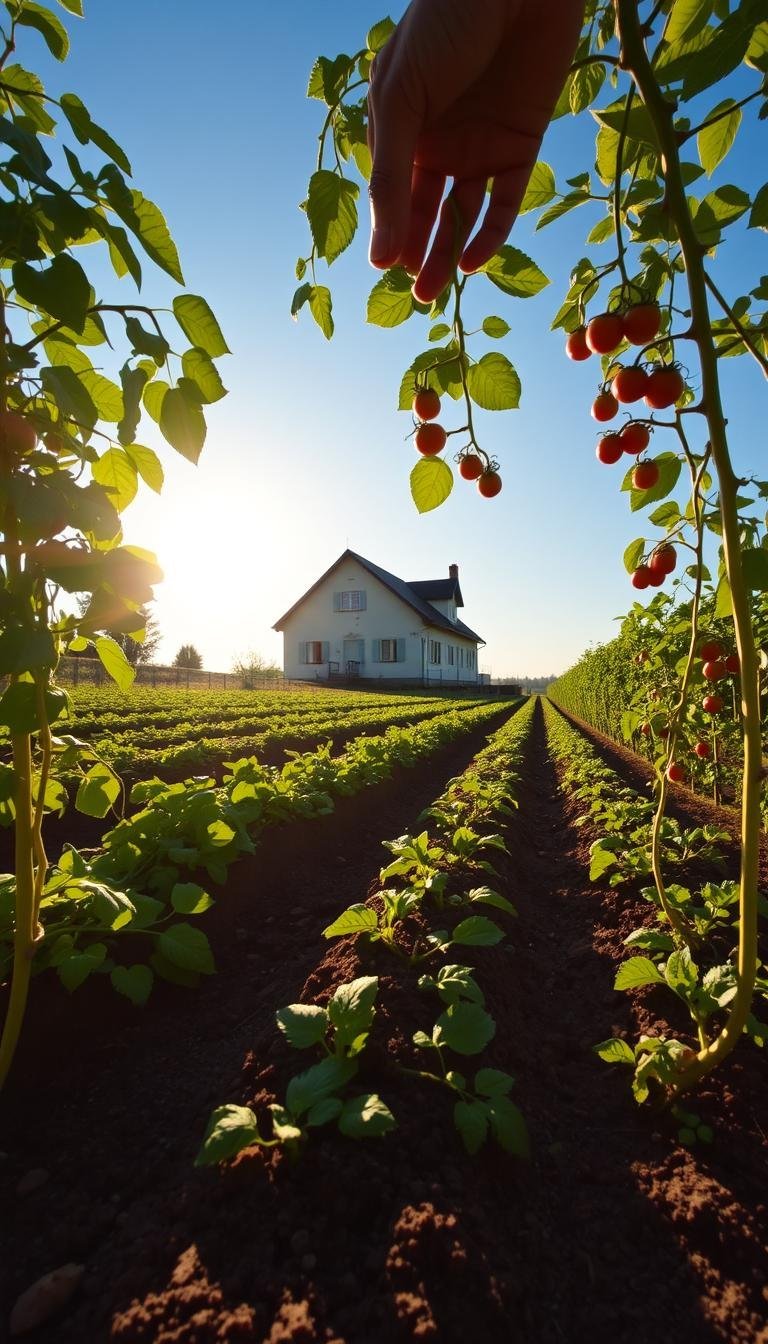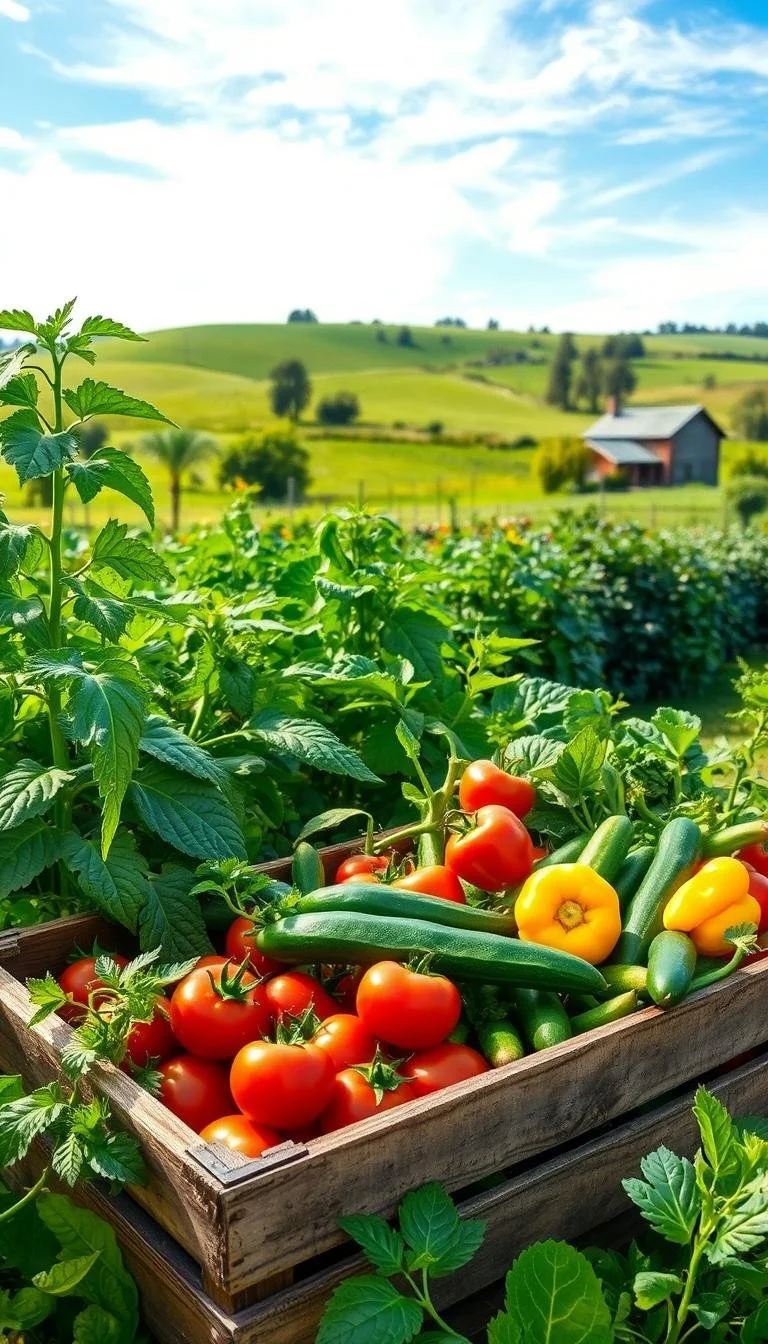(Hey! Some links in this post may be affiliate links — meaning I may earn a small commission if you buy through them, at no extra cost to you. As an Amazon Associate, I earn from qualifying purchases. I only share products I genuinely love and think you’ll find useful too. Read the full disclosure here).
Starting fresh or looking to update your garden? Vegetable garden ideas can change your outdoor area. Growing your own food is healthy, eco-friendly, and fulfilling. Even tiny spots can flourish with the right plan!
This guide has everything from sunny backyard layouts to creative containers. Discover how vertical gardens save room, companion planting helps plants grow, and planning for seasons keeps your harvest rich. These tips are for all gardeners, making growing veggies easy and rewarding.
🌿 Want to Take Your Garden to the Next Level?
If you're serious about growing your own food and becoming more self-reliant, The Self-Sufficient Backyard is a must-read...
🌱 Learn MoreLearn how to make a garden that’s both useful and lovely. Each idea here aims to make gardening enjoyable. Because, let’s face it, gardening should be fun!
Contents
- 1 1. Understanding Your Space: Location and Layout
- 2 2. Container Gardening: Perfect for Small Spaces
- 3 3. Raised Bed Gardening: Boosting Productivity
- 4 4. Vertical Gardening: Maximize Your Space
- 5 5. Companion Planting: Nature’s Helpers
- 6 6. Seasonal Planning: What to Grow When
- 7 7. Organic Gardening Techniques: Go Green!
- 8 8. Creative Garden Designs: Make It Unique
- 9 9. DIY Garden Projects: Hands-On Fun
- 10 10. Harvesting and Preserving Your Bounty
1. Understanding Your Space: Location and Layout
Starting a vegetable garden begins with understanding your outdoor area. A well-planned backyard vegetable garden layout ensures plants thrive and gardening stays manageable. Begin by assessing sunlight, soil, and space to create efficient Vegetables Garden Ideas tailored to your yard.
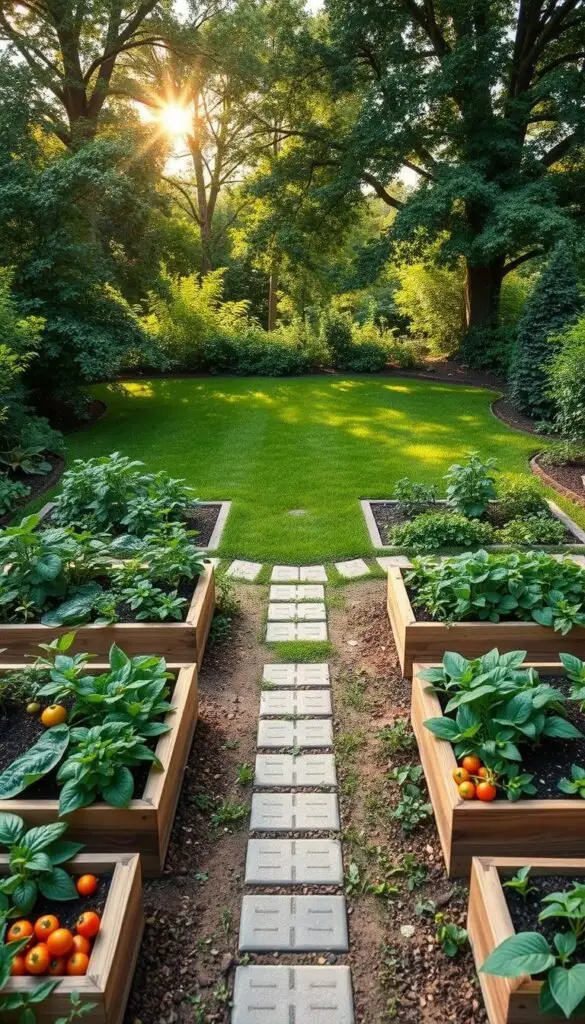
Choosing the Right Spot for Your Garden
Look for areas with good drainage and access to water. Avoid low spots where water pools. Consider these factors:
- Sunlight: Most veggies need 6–8 hours of daily sun
- Accessibility: Leave 2–3 foot pathways between planting zones
- Soil quality: Amend soil tests to identify nutrients and pH levels
Evaluating Sunlight and Shade Requirements
Track sunlight patterns over a week. Use these steps:
- Mark shaded areas with stakes or chalk
- Note peak sun hours in spring vs. summer
- Adjust plant placement for seasonal light changes
“Plants know their needs better than we do—listen to what your garden space offers.” – Organic Gardening Institute
Combine sun maps with plant preferences. Leafy greens like lettuce tolerate partial shade, while tomatoes require full sun. For small spaces, layer plants vertically or use containers to maximize backyard vegetable garden layout flexibility. Start small and expand as you learn your garden’s full Vegetables Garden Ideas!
2. Container Gardening: Perfect for Small Spaces
Container gardening is great for those with little yard space. It works well in apartments or city homes. You can turn patios, balconies, and windowsills into gardens. Small space vegetable gardening is easy with the right containers and plants.
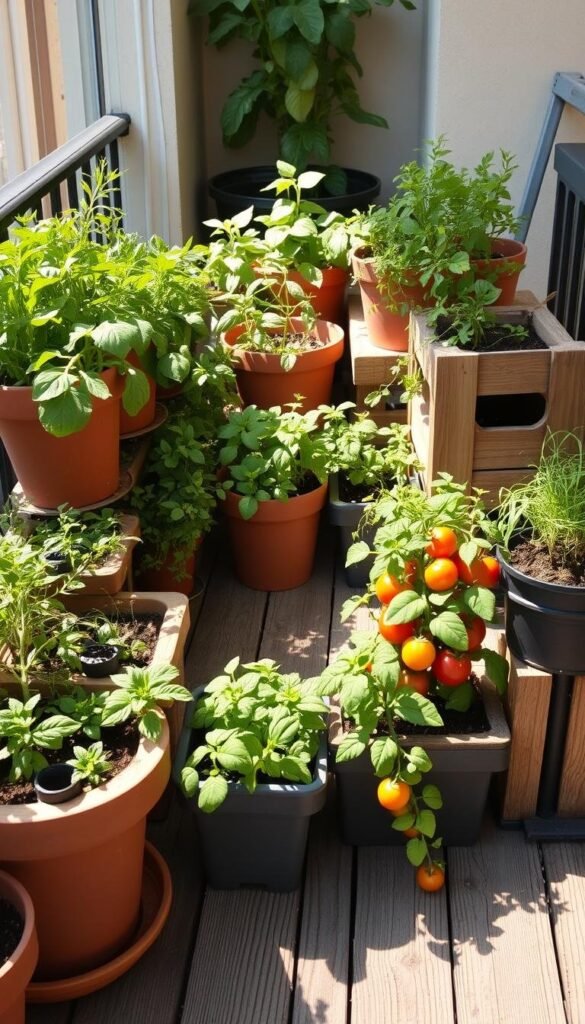
Top Containers for Vegetable Growing
First, pick the right container. Here are some good choices:
- Pots and planters: Clay pots breathe but dry out quickly.
- Grow bags: Fabric bags with drainage, great for tomatoes or peppers.
- Repurposed items: Use buckets, wooden crates, or old wheelbarrows for a unique look.
Best Vegetables for Container Gardens
Choose varieties that do well in small spaces. Try these:
- Lettuce and herbs: Do well in shallow containers (6-8 inches deep).
- Radishes: Ready in a month, perfect for small pots.
- Compact tomatoes: Look for patio or cherry varieties in 12+ inch pots.
For urban vegetable gardening ideas, mix veggies with edible flowers like marigolds in window boxes. Use a lightweight potting mix with compost. Water regularly to prevent drought stress.
3. Raised Bed Gardening: Boosting Productivity
Make your garden better with raised bed vegetable garden design. These beds help control soil, drain water well, and save space. Even small areas can grow more with less work and bending. Easy vegetable garden plans help beginners get started.
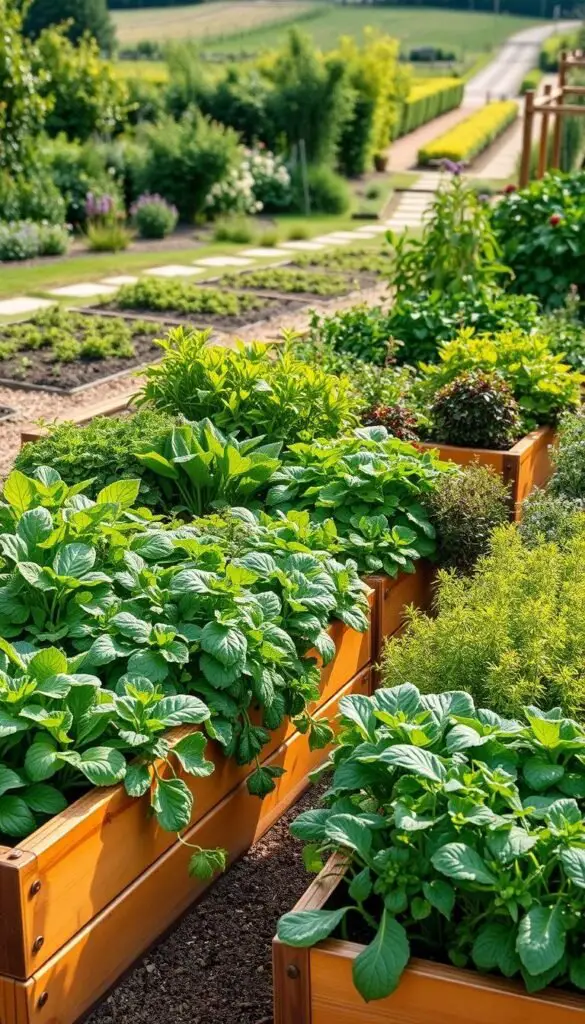
Benefits of Raised Beds
- Warmer soil starts growth earlier in spring.
- Less soil compaction means healthier roots and higher yields.
- Easier access reduces back strain and weeds.
- Customizable soil mixes improve plant health.
- Extend growing seasons with better drainage and airflow.
How to Build Your Own Raised Bed
Choose materials like untreated wood, composite, or stone. Wood is cheap but needs replacing often. Composite lasts long but costs more. Stone or metal is durable but pricier.
Build beds 3–4 feet wide and 8–12 inches deep. Leave 2 feet for walkways. Mix 60% topsoil with 40% compost for rich soil.
Pre-fabricated kits make setup easy, fitting any easy vegetable garden plans. Use drip irrigation to save water and mulch to keep it moist. Plant in zones to use space well. Start small and grow as you learn!
4. Vertical Gardening: Maximize Your Space
Vertical gardening turns small spots into green oases. It works on balconies, patios, or backyard corners. Small space vegetable gardening flourishes with vertical setups. People in cities around the world use it to grow food stylishly. Let’s see how to grow up instead of out.
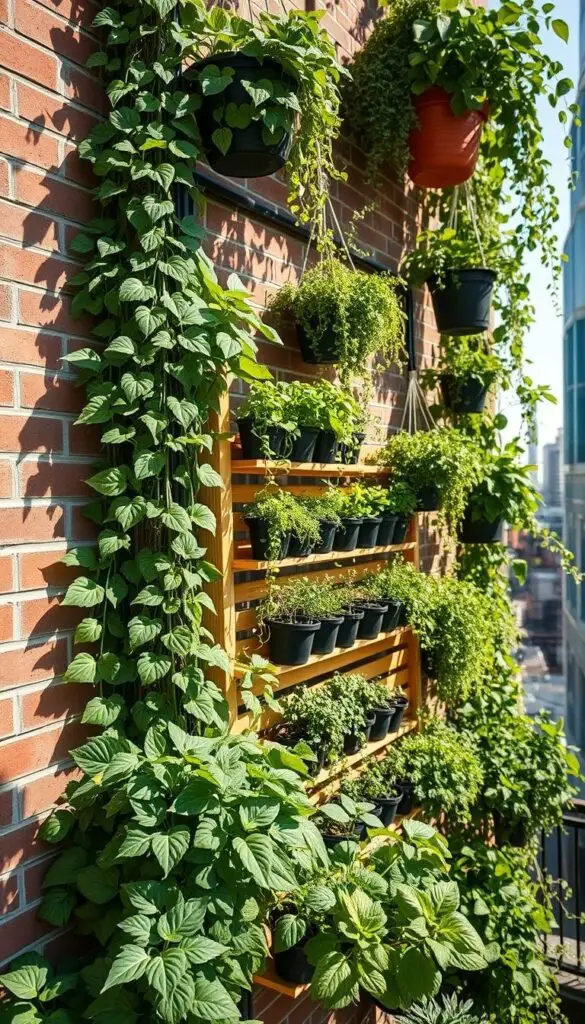
Best Vegetables for Vertical Growth
- Pole beans and peas climb naturally with minimal support.
- Cucumbers and small melons need sturdy frames to hold fruit weight.
- Indeterminate tomatoes and compact squash varieties adapt well with training.
Tips for Building a Vertical Garden Structure
- Choose lightweight but durable materials like bamboo or recycled wood.
- Position structures where plants receive 6+ hours of sunlight daily.
- Secure bases to prevent tipping in windy areas.
- Install drip irrigation lines or soaker hoses for even watering.
Urban gardening ideas like living walls or repurposed ladder frames make blank walls productive. Try hanging pots for strawberries or mesh nets for sprawling crops. Even small spaces, like 10×10 feet, can produce a lot of food.
5. Companion Planting: Nature’s Helpers
Companion planting vegetables is a smart strategy for organic gardening. It uses plant partnerships to boost growth and reduce pests without chemicals. Let nature’s teamwork guide your garden’s success.
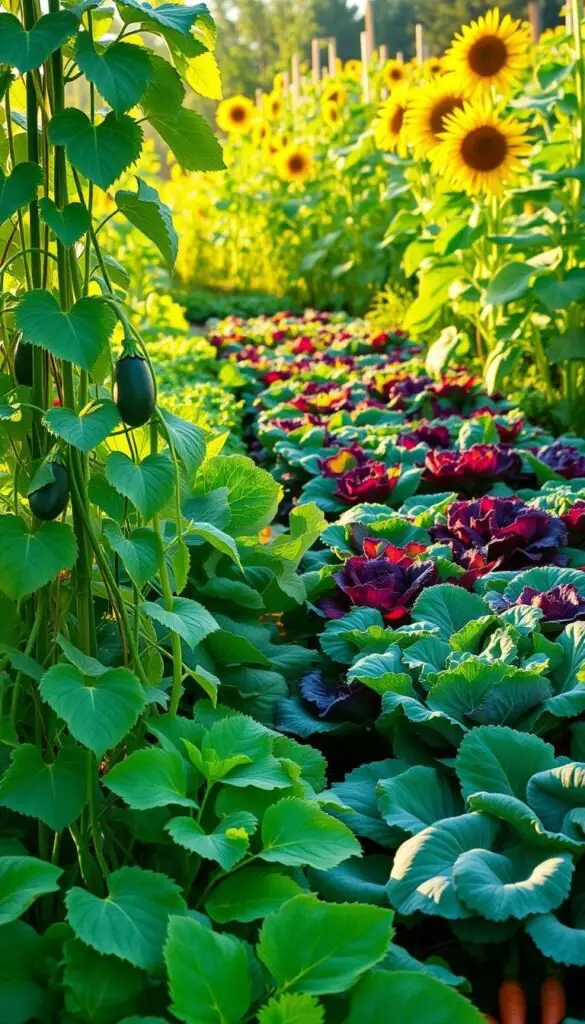
Key Vegetables That Pair Well Together
Some top combinations include:
- Tomatoes and basil: Basil repels pests and enhances tomato flavor.
- Carrots and onions: Their scent confuses carrot and onion flies.
- The “Three Sisters” (corn, beans, squash): Corn supports beans, beans fix nitrogen, and squash shades the soil.
- Cucumbers and sunflowers: Sunflowers provide vertical support and shade for cucumbers.
How Companion Planting Improves Growth
Plants work together in surprising ways. Marigolds deter nematodes when planted near root vegetables. Nasturtiums attract pollinators and distract aphids from veggies. Companion planting vegetables also improves soil health—legumes add nitrogen for leafy greens. Avoid clashes like onions with beans or potatoes with tomatoes to prevent nutrient competition.
“A well-planned garden thrives when plants support each other.” — USDA Sustainable Agriculture Research & Education
Incorporate these organic vegetable gardening tips to create a balanced ecosystem. Fewer pests mean less need for pesticides. Start small with tested pairs, and watch your garden flourish naturally.
6. Seasonal Planning: What to Grow When
A seasonal vegetable planting guide keeps your Vegetables Garden Ideas busy all year. First, match crops to their best temperatures and your area’s weather.
Understanding Planting Seasons
Cool-season veggies like spinach and radishes do well in spring and fall. Warm-season crops, like tomatoes and cucumbers, need summer’s warmth. Use USDA zones to find the right planting times. Check frost dates with local extension services to avoid damage from early cold.
Here are ways to extend your growing season:
- Use row covers to protect seedlings in early spring
- Mulch beds to keep soil warm in autumn
- Try cold frames for late-season harvests
Crop Rotation Basics for Healthy Soil
Rotate plant families yearly to keep soil rich. Group crops into four main types:
- Nightshades: tomatoes, peppers
- Legumes: beans, peas
- Brassicas: broccoli, cabbage
- Roots: carrots, beets
A 3-4 year rotation stops pests like blight or root maggots. For example, plant beans, then tomatoes the next year. This simple plan boosts your harvest and cuts disease risk.
7. Organic Gardening Techniques: Go Green!
Learning organic vegetable gardening tips begins with caring for the soil. Healthy soil leads to strong plants that fight off pests and diseases. Start by composting kitchen scraps and yard waste to naturally improve the soil.
Natural Pest Control Methods
Keep your plants safe without using harmful chemicals. Here are some easy vegetable garden plans tips:
- Plant marigolds or basil to repel insects
- Use a garlic and hot pepper spray as a natural repellent
- Introduce ladybugs to eat aphids
- Wrap sticky traps around stakes to catch flying pests
Benefits of Organic Fertilizers
Move away from synthetic fertilizers and choose natural options. Use compost, worm castings, or seaweed extract. These feed the soil’s microbiology and prevent chemical runoff. Fish emulsion boosts nitrogen, while bone meal adds phosphorus. Always test the soil’s pH yearly to adjust nutrient needs.
Be patient—organic gardening builds soil slowly but lasts long. Avoid synthetic pesticides to help beneficial insects. Every step, from planting to harvest, is a cycle that respects nature’s balance.
8. Creative Garden Designs: Make It Unique
Turn your Vegetables Garden Ideas into a personal style statement with backyard vegetable garden layout ideas. Whether you want whimsy or elegance, these tips can make your garden special.
Themed Garden Concepts
Let themes inspire your garden:
- Pizza Garden: Create a circle with tomatoes, basil, oregano, and peppers like a pizza wheel.
- Rainbow Layout: Plant by color—red tomatoes, yellow squash, purple eggplant—in a gradient spiral.
- Children’s Discovery Zone: Add fuzzy leaves (like lamb’s ear) and fun shapes (romanescu broccoli).
Artful Additions
Combine function with flair using:
- Hand-painted ceramic labels for plant markers.
- Metal trellises in animal or geometric shapes.
- Stepping stones with mosaic shards or pressed leaves.
Place a bench near herbs for a fragrant rest spot. Add edible flowers like marigolds for color.
9. DIY Garden Projects: Hands-On Fun
Make your garden a place for creativity with these DIY projects. They boost productivity and bring joy. You can use repurposed materials and make crafts that are fun for the whole family.
These ideas are great for all skill levels. They help you build simple things and have fun while doing it. You’ll learn problem-solving and how to care for the environment.
Simple Structures You Can Build
Turn old materials into useful garden items:
- Reclaimed Trellis: Use scrap wood to make a trellis for climbing plants. You’ll need wood and screws. It’s a bit harder but worth it. It takes 2–3 hours and costs $20–$30.
- Cold Frame: Old windows can help your plants grow longer. Use them with a raised bed to protect seedlings. You’ll need a window and 2x4s. It’s easy and quick, taking just 1 hour. It’s also very affordable.
- PVC Hoop House: Create a hoop house with PVC pipes and plastic. It’s great for winter crops. You’ll need PVC, plastic, and rebar. It’s a bit harder but takes only 3 hours. It costs $40–$50.
- Rain Barrel Irrigation: Use a barrel to collect rainwater and water your plants. You’ll need a barrel, spigot, and tubing. It’s easy and takes just 30 minutes. It costs $30–$50.
- Tool Organizer: Make a tool rack from a pallet. You’ll need a pallet and screws. It’s easy and takes 1 hour. It costs $15–$20.
Fun Garden Crafts for Kids
Get kids involved with these fun activities:
- Painted Rock Markers: Paint smooth stones to use as plant labels.
- Bug Hotel: Build a home for insects like ladybugs using bricks or logs.
- Fairy Garden: Create a tiny world among your veggies with miniature decor.
- Scarecrow: Use old clothes and straw to make a scarecrow to keep birds away.
- Bird Feeder: Make feeders from pinecones or milk jugs to attract birds.
These projects are both fun and educational. They help you learn about gardening while having fun. Whether you’re building or crafting, you’ll grow closer to gardening’s joys.
10. Harvesting and Preserving Your Bounty
As your garden grows, it’s time to harvest and preserve your hard work. A seasonal vegetable planting guide helps you know when to pick. Organic vegetable gardening tips keep your food fresh and tasty. Harvest most veggies in the cool morning to keep nutrients and flavor in.
Best Practices for Harvesting Vegetables
Start by picking leafy greens from the bottom up. This encourages new growth. Regularly pick snap beans and zucchini to keep them coming.
Look for signs like firm tomatoes and plump peppers. Carrots should come out easily. Don’t pull too hard on stems to avoid stunting growth. Overripe veggies can taste bitter, so check your guide for the best time to pick.
Preserving Techniques to Enjoy Year-Round
Freeze blanched veggies like peas or broccoli in labeled bags. Use water bath canning for foods like pickles. Pressure canning is best for beans or tomatoes.
Dehydrate herbs or slice tomatoes for sun-dried snacks. Ferment veggies like sauerkraut in airtight jars. Store potatoes and squash in cool places.
Share extra veggies with neighbors or local food banks. This helps your community and reduces waste. It keeps your organic gardening efforts going strong.

